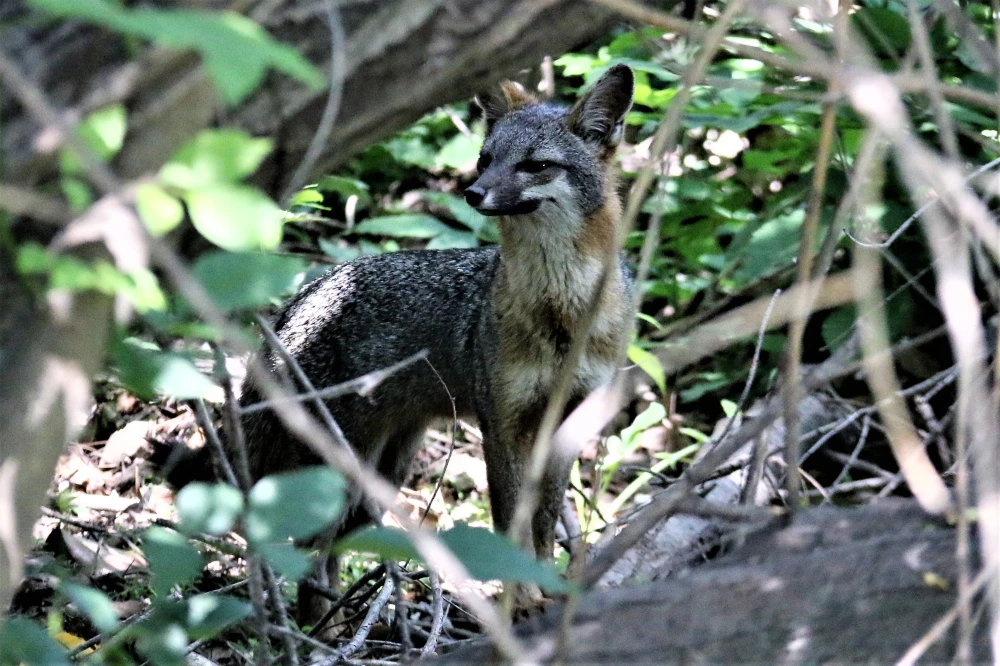Encounters: Well Now, Who Are You?
by William C. Leikam
President, CEO & Co-founder, Urban Wildlife Research Project
The overflow channel was wet from the rain that had fallen the night before. The female gray fox Big Eyes cautiously approached the feral cat Blackie, sniffed him, then carefully turned and trotted away. https://www.youtube.com/watch?v=zjpTzRfImwo&ab_channel=UrbanWildlifeResearchProject. The raccoon crashed through the weeds, directly at one of the trail cameras. Laimos dashed after it. The raccoon ran out onto the overflow channel and vanished off to the right edge of the frame with Laimos flying along behind. https://www.youtube.com/watch?v=08aDbhWOKeM&ab_channel=UrbanWildlifeResearchProject
Over the years of monitoring and documenting the gray foxes at the Palo Alto Baylands Nature Preserve, I have seen, both on camera and live how gray foxes generally tend to behave when they come face to face with another species, say for instance a raccoon, an opossum, or even a skunk. Most of the time these encounters are much like the one with Blackie the feral cat and Big Eyes, the female gray fox.
Recently there seems to be a shift in this behavior as is witnessed in the encounter between Laimos and the raccoon. No longer are the foxes allowing the others their space, but instead these two foxes are much more aggressive than is generally true of gray foxes.
Now for a bit about opossums. They are solitary meaning that they never team up with any other opossum and they are very seldom found in daylight. When I see them in the night on my trail cameras, they tend to move slow, methodically sniffing about along the trail. Harmless, and so solitary that if they meet with another opossum along the trail, they open their mouth wide to show that set of formidable teeth and they hiss at each other, and then they generally turn and leave, putting as much space between themselves as possible. If an opossum meets with any other animal, they react just the same; gaping mouth, sharp teeth, hiss and leave.
That’s not always the case, however. One surprising instance of this is where an opossum chased the gray fox pair, Laimos and Big Eyes. This event broke all of the “rules” of general opossum behavior and ever since I’ve wondered what could have caused this drama in the night. Why would an opossum try to take on a gray fox? Check it out here. https://www.youtube.com/watch?v=GyzSv_9E98Y&ab_channel=UrbanWildlifeResearchProject
Gray Foxes General Health
These two foxes appear to be in good health. The previous indication that one of them may have worms has not proven to be the case.
Total Numbers of Gray Foxes in the Palo Alto Baylands Nature Preserve
As of this date, we have two adult gray foxes living in the Palo Alto Baylands Nature Preserve.
Section II
Update for the Urban Wildlife Research Project
Bill’s new book The Road to Fox Hollow has been released and can be found at Barnes & Noble Booksellers https://www.barnesandnoble.com/w/the-road-to-fox-hollow-wc-leikam/1140931306?ean=9781955690072 and directly from the publisher Di Angelo Publications at https://www.diangelopublications.com/books/the-road-to-fox-hollow. Dr. Marc Bekoff has an interview with Bill and that can be accessed at The Social and Emotional Lives of Urban Gray Foxes .
Bay Nature Magazine – How to be a Fox, the article about Bill and his ethological approach to his study of the gray fox is online here: https://baynature.org/article/how-to-be-a-fox/ Many are calling this a major article in the wildlife press.
BE SURE TO check out our YouTube Channel for some incredible wildlife videos at https://www.youtube.com/channel/UC5ujc7p8dU1-O5AbPAWz2_Q and our Facebook page.
LIVE & ONLINE Bill is schedule to make an online presesntation for the Point Reyes Birding & Nature Festival. Register now as the registration closes on April 15th. https://www.pointreyesbirdingfestival.org/
Bill has an additional live event coming up also in April 23rd at Safari West and on May 7th he will be live at Safari West https://www.safariwest.com/ in the Elephant Room.
Undoubtedly the best Radio interview ever – KALW (PBS program Crosscurrents) – by Sofie Kodner during December 2020 – Broadcast 1/11/2021 5:00 PM. Check it out here https://www.kalw.org/post/bay-area-wildlife-habitats-are-disappearing-fox-guy-has-plan
You can access Bill’s PowerPoint presentation Corridors & Connections: Sustaining the Health of All Wildlife presented during the October 24th P-22 Urban Wildlife Festival here: https://www.youtube.com/watch?v=Dh4MQL1D1Cc
Section III
Gray Fox, Baylands Goals
Within the permit that allows the Urban Wildlife Research Project to conduct its study of the behavior of the gray fox at the Palo Alto Baylands Nature Preserve, the objectives covered area:
- Monitoring of urban gray fox Denning sites in Palo Alto Baylands.
This is being accomplished during the period when the gray foxes use a den site. It is one of the prime locations for gathering most of the behavioral data of the litter and for adults alike.
- Assessment of status and population trends of Baylands urban gray foxes
Since January 2019 a pair of resident gray foxes have claimed territory at the Palo Alto Baylands Nature Preserve.
- Identification of habitat features that promote the presence of urban gray foxes
After considering this and talking with people who know how to restore habitats, we need to assess what kinds of plants, including the Alkaline Salt Bush, would grow best along the edge of the saltwater channel and alongside the marsh. We need to grow a permanent habitat that contains the corridors and plant it as soon as possible. We’ll keep an eye on this as this is a critical link between the southern region of the Baylands and the northern region.
- Assessment of reproductive success and identification of factors that promote successful reproduction
Open up the pinch-point along Matadero Creek by developing thickets that link one area to another, instead of the present “islands”.
- Identification and assessment of possible dispersal travel routes.
Presently there can only be guesses as to dispersal travel routes. We intend to make this important question much more concrete when we attain our collaring/take/capture permit from the Department of Fish & Wildlife.




